How to Find My Decorating Style Your Personal Guide
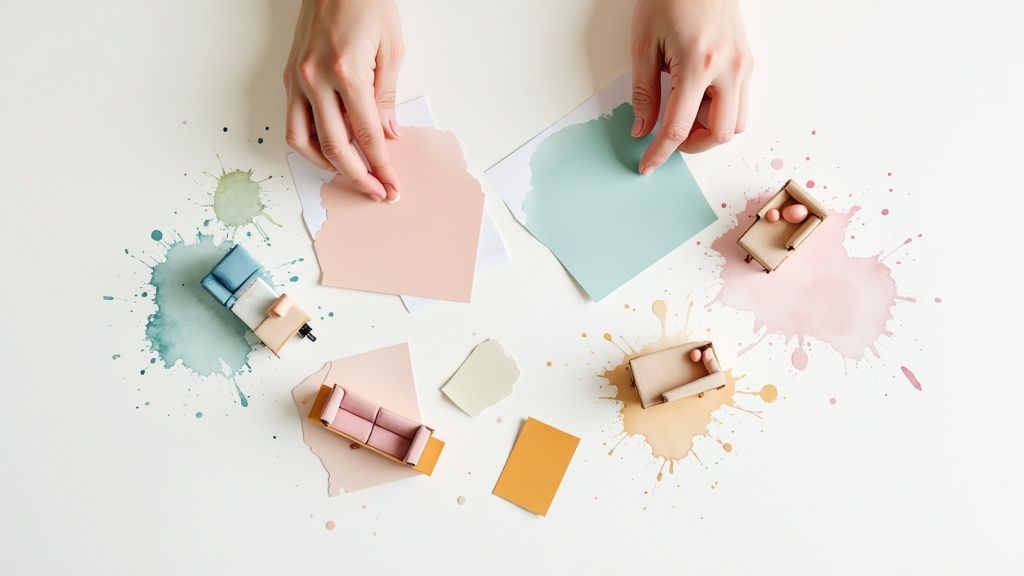
Feeling lost in a sea of design trends? I get it. The first step to finding your unique decorating style isn’t about scrolling through Pinterest—it’s about looking inward. We’re not trying to slap a label like “Modern” or “Bohemian” on your home. The real goal is to figure out what truly makes a space feel like yours.
Your Path to a Personal Decorating Style Starts Now
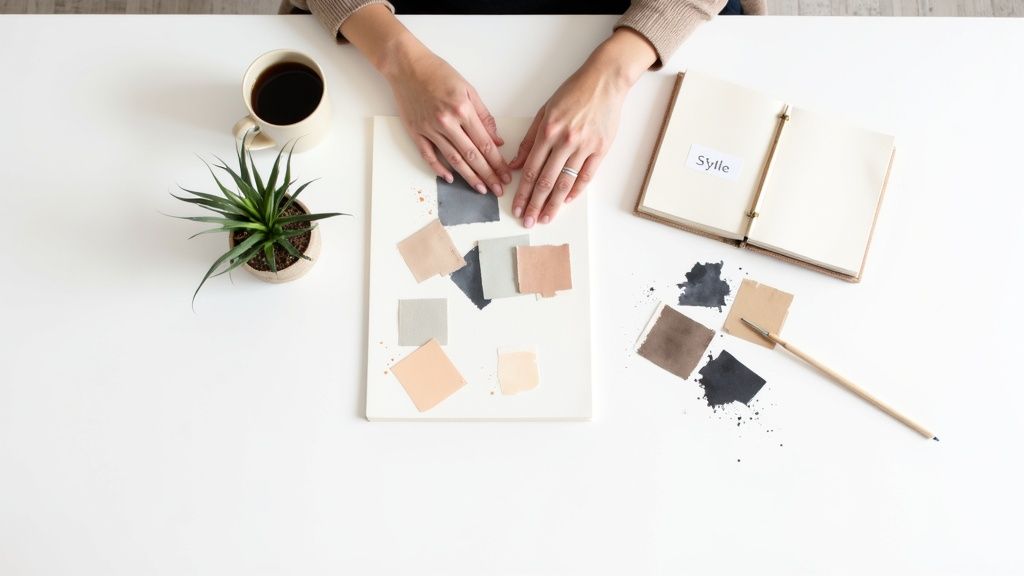
It’s easy to feel completely swamped by the endless inspiration online. But the truth is, your perfect style isn’t hiding in a magazine; it’s a direct reflection of who you are. This guide is here to demystify that process, turning what feels like a huge task into a genuinely fun journey of self-discovery. Forget about rigid rules or needing a design degree.
We’re going to focus on practical, actionable steps that connect your personal taste to real-world design choices. You’ll learn how to translate those gut feelings you have about a room into a concrete visual language. It’s all about building confidence and creating a space that feels authentic to you.
The most successful interiors tell a story about the people who live in them. Your home should be a collection of what you love, brought together in a way that feels cohesive and comfortable.
Ready to move beyond generic trends and create something that lasts? Our approach will help you:
- Understand Your Core Preferences: We’ll pinpoint the colors, textures, and general moods you naturally gravitate towards.
- Create a Practical Vision: You’ll learn to use simple tools like digital mood boards to capture and refine all those great ideas.
- Build a Cohesive Space: I’ll show you how to tie different elements together for a harmonious, put-together look.
This is the real start of creating a beautiful home that actually supports your lifestyle. And if you find you need a bit of extra guidance along the way, you can always get professional help with designing a room.
Look Within Before You Look Outward for Inspiration
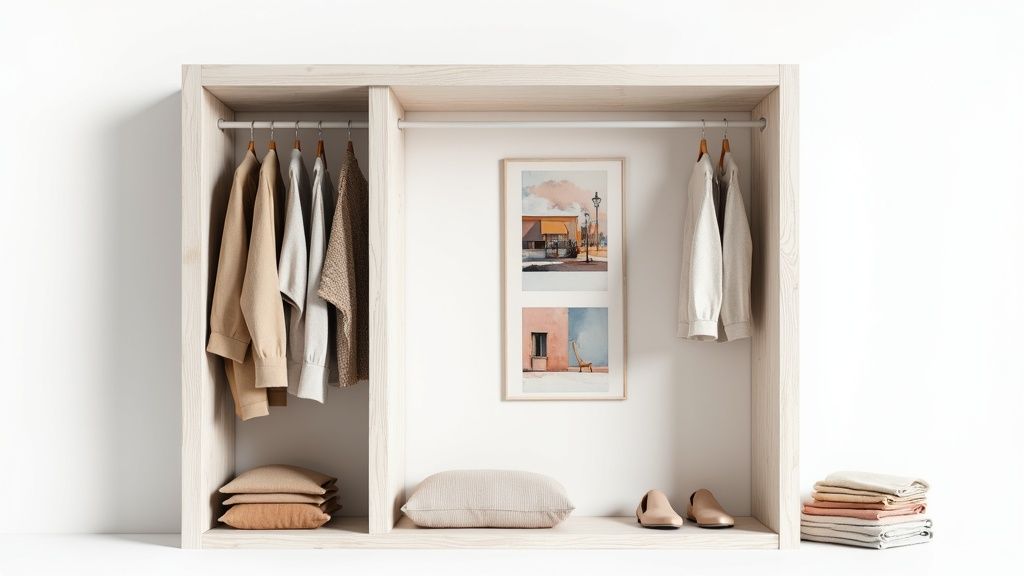
Before you ever pin an image to a mood board, take a moment. The best clues to your personal style aren’t out there on the internet—they’re already hiding in plain sight, right inside your home. The secret to creating a space you’ll genuinely love is learning to translate your own personality and lifestyle into a visual language.
A fantastic, and maybe surprising, place to start is your own closet. Go ahead, open it up and take a really honest look at the clothes you reach for time and time again. What colors do you gravitate towards? Are you all about soft, natural fabrics like cotton and linen, or do you prefer the luxe feel of silk or the cool edge of leather?
The patterns and textures you choose to put on your body are a powerful preview of what will make you feel truly at home in a room. That navy blue sweater you adore could be the perfect inspiration for an accent wall. The nubby texture of your favorite blanket is a direct cue for the kind of throws you should have on your sofa. This isn’t about making your house look like your wardrobe; it’s about spotting the consistent themes that define your comfort zone.
By grounding your style in your daily life and personal history, you’ll create a foundation that is authentic, functional, and timeless.
Connect Feelings to Spaces
Next, let’s think about places outside your home where you’ve felt completely at ease, relaxed, or inspired. Was it that cozy neighborhood coffee shop with the worn leather chairs and warm lighting? Or maybe a minimalist hotel lobby that felt like a breath of fresh air?
Don’t just picture the place—try to remember the feeling. Then, work backward to figure out what created it.
- The Cozy Coffee Shop: Was it the mix of dark wood, low-key ambient music, and the rich smell of coffee? That might mean you lean toward a rustic, traditional, or even industrial aesthetic.
- The Serene Hotel Lobby: Did you feel calm because of the clean lines, neutral colors, and wide-open, uncluttered space? This points directly to a minimalist, Scandinavian, or modern style.
Try to jot down three to five of these places and the specific details that made them memorable. This simple exercise is incredibly effective because it helps you connect an abstract feeling to concrete design elements. Once you understand why you like a certain atmosphere, you’re well on your way to knowing how to create it for yourself.
Finding Inspiration in a Digital World
Once you have a better feel for your personal tastes, it’s time to start gathering visual evidence. This is where the fun really begins, and modern tools can help you turn those gut feelings into a concrete visual plan without getting lost in an endless sea of images.
The key is to use platforms like Pinterest and Instagram strategically. Instead of creating one giant “Dream Home” board, get granular. Try making several hyper-specific boards like “Cozy Living Room Textures,” “Moody Kitchen Color Palettes,” or “Curvy Bedroom Furniture.” This focused approach is a game-changer for spotting patterns you’d otherwise miss—like a subconscious love for bouclé armchairs, natural oak, or a very particular shade of olive green.
Let Technology Be Your Guide
The way we approach interior design has completely shifted. Digital mood boards, virtual room planners, and style quizzes are no longer novelties; they’re how millions of people access incredible design ideas right from their couch. You can dive deep into niche aesthetics, like these inspiring indoor cactus garden ideas, to see how small details can define a larger style. For a closer look at these trends, check out the latest digital design statistics from Halman Thompson.
Remember, your goal isn’t to replicate a room you see online. It’s about collecting the individual elements that speak to you. A single pin of a unique lamp, a beautiful color pairing, or a striking piece of art can be the spark that ignites your entire vision.
Beyond just collecting images, technology now offers some seriously cool ways to get personalized guidance. AI-powered design tools, in particular, can be an amazing launchpad for your creativity.
- Virtual “Try Before You Buy”: Many apps use your phone’s camera to show you exactly how that new sofa or rug will look in your actual room. No more guesswork.
- Smart Recommendations: Some tools analyze your saved images and start suggesting products, color palettes, and layouts that align with your developing style. It’s like having a personal shopper who just gets you.
- AI-Powered Brainstorming: This is where things get really interesting. You can upload a photo of your own space and have an AI generate completely new design concepts in seconds, showing you possibilities you never would have thought of on your own.
These tools are getting incredibly good. If you want to explore this further, our guide on how to choose the best AI app for interior design can help you find the right one for your project.
Defining and Refining Your Signature Aesthetic
Alright, your mood boards are officially overflowing with inspiration. Now for the fun part: connecting all those dots and figuring out what it all means. This is where you start to translate all those saved pins and screenshots into a real, cohesive decorating style that feels like you.
Don’t get hung up on finding the perfect label. The most interesting and personal homes are almost never just one “style.” Instead, think of this as creating a personal recipe for your space. We’re moving past generic terms to build a unique framework that will make every decision—from paint colors to sofa shapes—feel intentional and right.
Create Your Personal Style Guide
Let’s distill that vision into a simple, powerful tool: a personal style guide. This is essentially a one-page cheat sheet that outlines the DNA of your home’s aesthetic. It’s your north star for every decorating choice you make.
Start by breaking it down into three core lists:
- Your Color Palette: Look through your inspiration and pull out the 3-5 core colors you see again and again. You’ll want a go-to neutral, a secondary color, and one or two accent shades that make your heart sing.
- Your Material Shortlist: What textures are you drawn to? Is it the cozy feel of rattan and linen, the luxe touch of brass and velvet, or the rugged character of reclaimed wood and leather? List them out.
- Your Key Furniture Shapes: Pay attention to the silhouettes that catch your eye. Do you prefer the sharp, clean lines of modern pieces or the soft, inviting curves of more traditional furniture? Are you saving images of low-slung sofas or tall, elegant armchairs? Getting familiar with the different furniture types and styles will really help clarify your preferences here.
Think of this guide not as a set of rigid rules, but as a compass. When you’re out shopping and feel that wave of indecision, pull it up. Ask yourself, “Does this fit my palette, my materials, and my shapes?” It’s a game-changer.
Deconstructing Popular Interior Design Styles
To help you pinpoint the elements you love, it’s useful to understand the building blocks of established styles. This isn’t about picking one and sticking to it, but about borrowing ingredients for your own unique mix. Think of it like a chef learning classic recipes before creating their own signature dish. The table below breaks down a few popular styles into their core components.
| Design Style | Key Characteristics | Common Materials | Color Palette |
|---|---|---|---|
| Scandinavian | Simplicity, minimalism, functionality, light-filled spaces, hygge (coziness) | Light woods (birch, pine), wool, linen, felt, leather | White, gray, black, pale blues, soft pastels |
| Bohemian | Eclectic, free-spirited, layered textures, global patterns, plants | Rattan, macrame, natural fibers, wood, colorful textiles | Earth tones, jewel tones, vibrant patterns, metallics |
| Mid-Century Modern | Clean lines, organic curves, functionality over form, minimalist ornamentation | Teak, walnut, plastic, metal, glass, vinyl | Orange, brown, olive green, mustard yellow, teal |
| Industrial | Raw, unfinished feel, exposed structural elements, open-plan layouts | Exposed brick, concrete, steel, distressed wood, copper | Neutral and monochromatic (gray, black, white), with warm wood tones |
| Modern Farmhouse | Rustic charm meets modern simplicity, comfortable and practical | Reclaimed wood, shiplap, galvanized metal, cotton, wrought iron | Neutral (white, beige, gray), with black accents and natural wood |
Use this as a starting point. Maybe you love the raw materials of Industrial style but prefer the warm, cozy color palette of Modern Farmhouse. Great! That’s the beginning of your personal style.
Master the Art of the Style Mix
The days of strictly adhering to one design doctrine are long gone. In fact, recent industry reports show a major shift away from singular styles. A whopping 33% of top designers now favor maximalism, with another 33% championing eclectic design. This trend screams one thing: personalization is king. People want spaces that tell their own unique story by artfully blending different elements.
The infographic below shows just how central digital tools are to gathering these wonderfully diverse ideas.
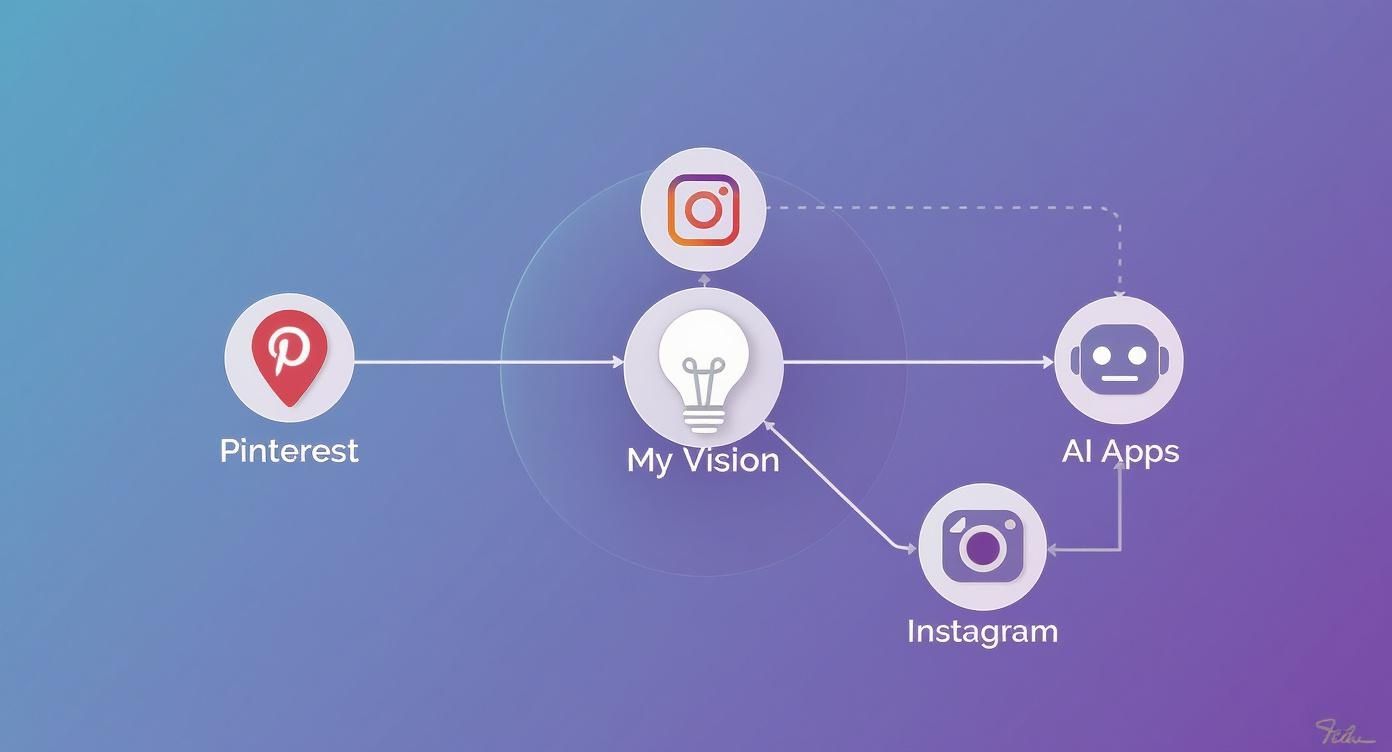
As the visual shows, your vision isn’t built from a single source; it’s a collage of ideas you’ve pulled from all over. To create a truly signature aesthetic, you might pair the clean lines of Minimalism with the warm, organic textures of Rustic decor. Or maybe you can explore specific historical aesthetics like furniture from the Victorian era and mix a few ornate pieces into a contemporary room for a bit of drama. It’s all about creating a thoughtful blend, not just picking a style from a catalog.
Put Your Style to the Test with a Mini-Project
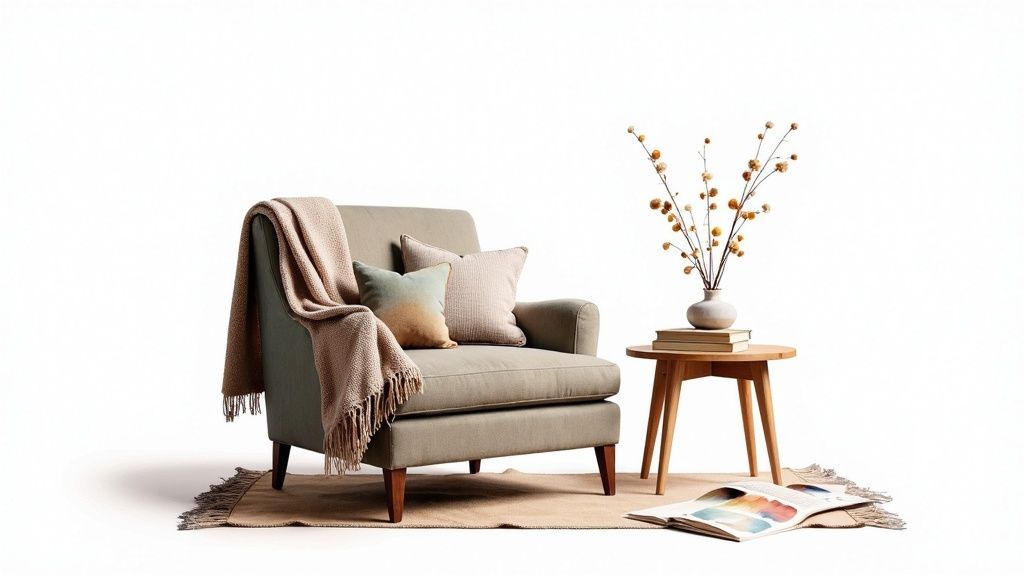
Jumping headfirst into a massive room renovation is a recipe for creative burnout and budget anxiety. Before you start knocking down walls or buying all new furniture, it’s a much smarter move to give your budding style a real-world test drive.
This hands-on approach is how you really find out what works—not just on a Pinterest board, but in your actual, lived-in space. By starting small, you give yourself the freedom to experiment without the pressure of a huge, expensive commitment. Think of it as a low-risk design lab for high-impact results.
Where to Start Your Style Experiment
Pick a small, contained space to be your personal design playground. The goal here is simple: see how your chosen colors, textures, and decor items actually look and feel. Pay attention to how they play with your home’s natural light as it changes from morning to night.
Here are a few perfect spots to get started:
- A Bookshelf Vignette: Clear off a shelf or two and start from scratch. Arrange a few new pieces—maybe a funky ceramic vase, a small sculpture, or a framed print that captures the vibe you’re after. It’s an amazing way to see how new colors and shapes interact.
- The Entryway Table: This is your home’s first impression! A new lamp, a stylish catch-all tray, or a different mirror can completely change the mood the second you walk through the door.
- A Cozy Reading Nook: This is the ideal spot to experiment with textiles. Try out some new pillow covers or drape a throw blanket in a fabric you’ve been eyeing, like bouclé or chunky wool. Live with it for a few days and see how it feels.
This small-scale testing is where abstract ideas meet reality. It’s one thing to love an object in a store; it’s another to truly love it in your own home.
Feeling a bit more daring? Try painting a small accent wall. The wall behind your headboard or in a tiny powder room is a perfect candidate. Living with a new color on a small scale is the single best way to know if you’ll still love it when it’s covering all four walls of your living room. This turns the process into a fun evolution, not one giant, stressful decision.
A Few Common Questions About Finding Your Decorating Style
As you start figuring out your personal aesthetic, you’re bound to hit a few snags. It’s totally normal to feel a bit lost when theory meets the reality of your own home. Let’s walk through some of the most common questions that pop up on this journey.
What If I’m Drawn to More Than One Style?
First off, that’s fantastic! The most interesting and personal homes are almost never textbook examples of a single style. Think of it like this: you’re not a follower, you’re a curator, blending different vibes to create something that’s uniquely you.
The trick is to find a common thread that weaves everything together.
Let’s say you love both the clean, bright feel of Scandinavian design and the free-spirited textures of Bohemian decor. You can absolutely make them work together. The key is to anchor the space with a simple, neutral Scandinavian color palette—whites, grays, and light woods. Then, layer in those cozy, eclectic Boho elements like a plush shag rug, macrame wall art, and tons of leafy green plants. The consistent color scheme makes the whole look feel deliberate and pulled together, not messy.
Another way to do this is by focusing on a shared material or finish. Maybe you’re into the sleek lines of Mid-Century Modern furniture but also love the raw, edgy feel of Industrial design. You can easily pair them if you stick to pieces that share a similar dark wood tone.
Your goal isn’t to perfectly replicate a single look from a catalog. It’s to hand-pick the specific details you love from different styles and create a harmonious blend that tells your story.
How Can I Possibly Find My Style on a Shoestring Budget?
This is a big one, but I have good news: figuring out your style is completely free. The real work is about observation and self-discovery, which happens long before you ever pull out your wallet. It’s all about pinning, saving, and daydreaming.
When you are ready to start making changes, you don’t need a huge budget. Here are a few of my favorite wallet-friendly tricks:
- Start by “shopping” your own home. Before you even think about buying something new, see what happens when you rearrange the furniture. You’d be surprised how different a room can feel with a fresh layout.
- Embrace the thrill of the hunt. Thrift stores, Facebook Marketplace, and local flea markets are gold mines for one-of-a-kind pieces that have way more character than anything you can buy new.
- Focus on high-impact, low-cost updates. A can of paint is hands-down the cheapest way to completely transform a room. Little things like new pillow covers, an updated rug, or even just swapping out the hardware on your cabinets can make a massive difference.
Remember, true style is born from creativity, not a big budget.
Ready to see all these ideas come to life in your own home? With RoomGenius, you can upload a photo of your room and instantly see it redesigned in countless styles. Discover your home’s true potential today!